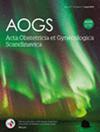Risk factors for lymph ascites after surgery for endometrial cancer and impact on lymphedema of the legs. A prospective longitudinal Swedish multicenter study
Abstract
Introduction
The primary aim was to determine the occurrence of lymph ascites 4–6 weeks after surgery for endometrial cancer. Secondary aims were to assess risk factors for lymph ascites and the association with lymphedema of the legs.
Material and Methods
This was a post hoc analysis of an observational prospective multicenter study, performed in 14 Swedish hospitals that included 235 women undergoing surgery for early-stage endometrial cancer between June 2014 and January 2018; 116 underwent surgery including pelvic and para-aortic lymphadenectomy and 119 had surgery without lymphadenectomy. Lymph ascites (free intraabdominal fluid or encapsulated pelvic or para-aortic fluid) was assessed by vaginal ultrasound 4–6 weeks postoperatively. Lymphedema was assessed using circumferential measurements of the legs preoperatively and 1 year postoperatively, enabling estimation of leg volume. A BMI-standardized leg volume increase ≥10% was classified as lymphedema. Evaluation of risk factors was performed using multiple logistic regression.
Results
Lymph ascites 4-6-weeks postoperatively occurred in 28.5% (67/235) of the women. The estimated volume of the lymph ascites in these women was mean 28 mL (standard deviation 48 mL) and median 14 mL (interquartile range 2–36 mL). Lymphadenectomy was a risk factor for lymph ascites (aOR 9.97; 95% CI 4.53–21.97) whereas the use of minimally invasive surgery (aOR 0.50; 95% CI 0.25–0.99) reduced the risk. Twenty-two of 231 women (9.5%) developed lymphedema of the legs 1 year after surgery. The presence of lymph ascites was predictive of lymphedema (aOR 3.90; 95% CI 1.52–9.96).
Conclusions
Lymph ascites was common 4–6 weeks after surgery but in a low and clinically insignificant volume. Lymphadenectomy was a strong risk factor for lymph ascites and the use of minimally invasive surgery seemed to reduce the risk. Detection of lymph ascites at early postoperative follow-up may be a means of selecting patients at high risk of developing lymphedema after treatment with endometrial cancer for preventive measures against lymphedema progression.


 求助内容:
求助内容: 应助结果提醒方式:
应助结果提醒方式:


